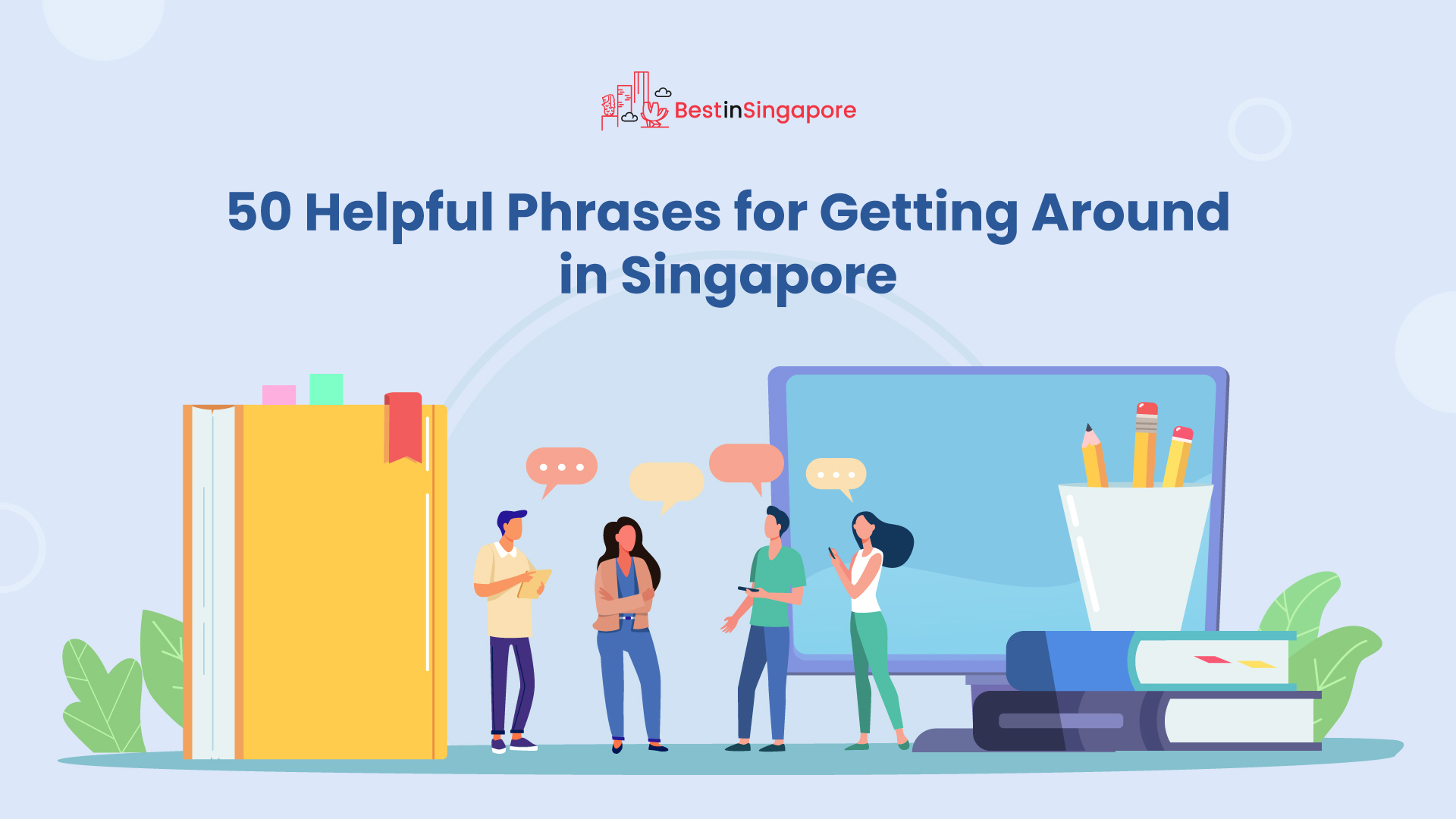50 Helpful Phrases for Getting around Singapore
If there’s an Asian city that’s truly a cultural melting pot, it would be Singapore. And the biggest indication of this is the fact that there are 4 official languages on the island: English, Mandarin, Malay, and Tamil.
While this means that you can always default to English in case words fail, you’ll also find that learning a local phrase or two can go a long way.
If you have an upcoming trip to Singapore, then you’ve come to the right place. In this article, we’ve put together 50 of the most helpful phrases to use when getting around Singapore.
Basic Chinese Phrases and Words
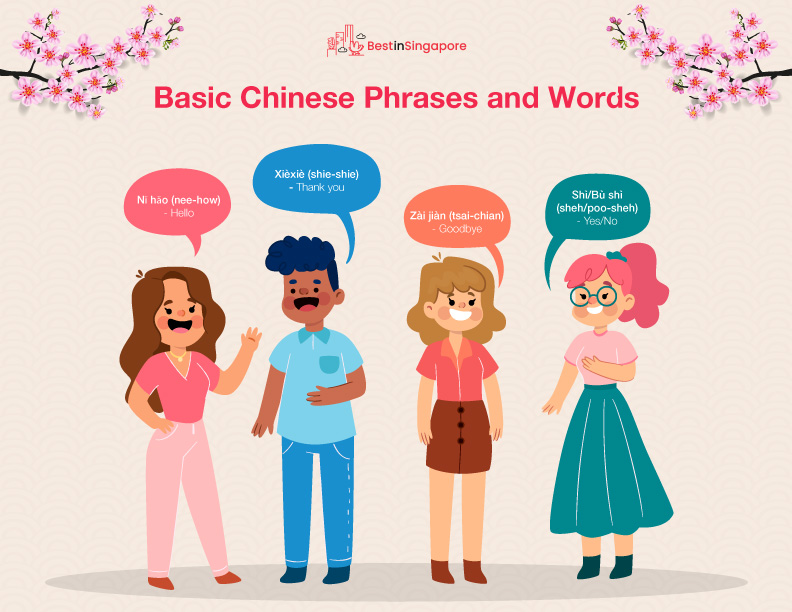
The Chinese are the largest ethinic group in Singapore, so it shouldn’t be a surprise to know that the majority of locals can speak Mandarin. Knowing a little bit of Mandarin will surely impress the locals, and can get you out of confusing situations!
Before we proceed, let’s talk a bit about pinyin first.
Essentially, pinyin uses the Latin alphabet to show you how Chinese words are pronounced. For instance, 我 is pronounced as wŏ.
The tone markings you see represent the pitch of your voice when pronouncing the vowel. This is important because mispronouncing words can cause misunderstanding.
Not sure how to pronounce these tone markings? Check out this video below:
It does take a bit of practice to get used to, but don’t fret. Locals are very understanding with foreigners!
We’ve also included a rough pronunciation guide next to the pinyin below, just to give you an idea of how words should be pronounced. So without further ado, let’s get right into it!
1. Hello — Nǐ hǎo (nee-how)
This is the most basic and commonly used Mandarin phrase to greet people. “Nǐ hǎo” literally translates to “you good.”
2. How are you? — Nǐ hǎo ma? (nee-how-ma)
Once you know how to say “hello” in Mandarin, then it should be easy to remember “how are you?” Simply add “ma” at the end to indicate that it is a question.
3. Good morning — Zǎo ān / zǎo (tsao-ahn)
This is the most casual way of greeting someone in the morning. You can also use this as a substitute for “hello.”
4. Goodbye — Zài jiàn (tsai-chian)
This is the standard way of saying goodbye to someone. Alternatively, you can also say “bái bái,” which is literally how you pronounce “bye-bye.”
5. Good night — Wǎn ān (wan-ahn)
You can also say this as an alternative to “goodbye” during evenings, although it is more often used in a formal context.
6. Yes — Shì de (sheh-tuh)
To answer affirmatively, use this phrase. In this context, “shì” means “yes” while “de” is used for emphasis.
7. No — Bù shì (poo-sheh)
Once you know how to say “shì,” this one should come easy. Simply add “bù” at the beginning to say that something is incorrect.
8. Thank you — Xièxiè (shie-shie)
Here’s another polite phrase that everyone should know. You can also add “nin” (meaning “you”) at the end in more formal contexts.
9. You’re welcome — Bú kèqì (poo-kuh-chee)
This is the most common way of saying you’re welcome. It literally means “don’t be polite.”
10. I’m sorry — Duìbùqǐ (twei-poo-chee)
This is another polite phrase that will come in handy in situations where you’ve made a mistake or did something wrong.
Essential Chinese Phrases for Travellers
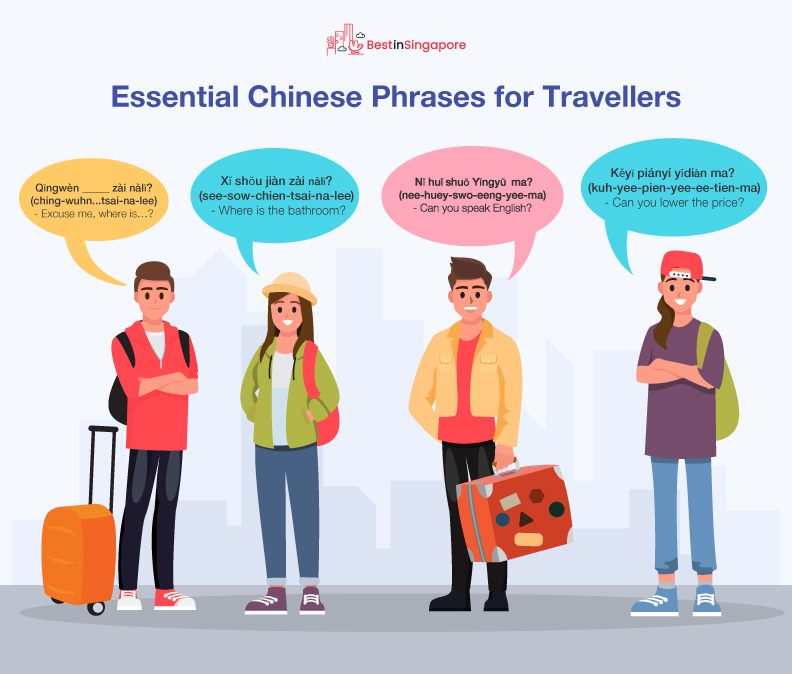
Here are more travel-specific phrases that will help you get around Singapore.
11. Excuse me, where is…? — Qǐngwèn _____ zài nǎlǐ? (ching-wuhn…tsai-na-lee)
This sentence pattern is the most basic one to ask someone for directions. Insert the name of your destination before “zài nǎlǐ,” which literally means “where?”
For example, “Qǐngwèn, Bugis Junction zài nǎlǐ?”
On that note, you can also use “qǐngwèn” as a general opener when you approach someone for questions. It’s simply more polite that way.
12. How do I get to…? — _____ zěnme qù?(…chuh-muh-chee)
Here’s another way of asking for directions. Similar to the previous sentence pattern, simply say the name of your destination first.
13. Where is the bathroom? —Xĭ shŏu jiàn zài nǎlǐ? (see-sow-chien-tsai-na-lee)
This literally translates to “where is the hand-washing room?” To improve your chances of being understood, you can also imitate the action of washing your hands.
14. How much? — Duō shǎo qián? (twuh-shao-chien)
Use this phrase in case there’s no written price on an item. Normally, people use this phrase in street markets.
15. Can you speak English? — Nǐ huì shuō Yīngyǔ ma? (nee-huey-swo-eeng-yee-ma)
Switching to English instead of talking to someone in English straight away is a more courteous way of approaching people. If you have trouble communicating in Chinese, you can use this when asking someone for directions or general questions.
Luckily, the majority of locals know how to communicate in basic English, just in case your attempts at speaking Chinese fall through!
16. I don’t understand — Tīng bù dǒng (ting-poo-tong)
Can’t keep up with locals who speak Mandarin at lightning speeds? Politely tell them that you don’t understand, followed by “Nǐ huì shuō Yīngyǔ ma?”
17. Can you lower the price? — Kěyǐ piányí yīdiǎn ma? (kuh-yee-pien-yee-ee-tien-ma)
Haggling is a normal part of Chinese culture, so might as well put those bargaining skills to the test! If you find yourself exploring night markets, it’s a common practise to always ask for lower prices before purchasing an item right off the bat.
18. I’m just looking — Wǒ kàn yīxià (woh-kahn-ee-syah)
Tired of salespeople trying to hard-sell a product to you? Use this if you prefer to be left in peace while you shop and look around.
19. I’ll take this one — Wǒyào zhège (woh-yao-chuh-kuh)
So now that you’ve decided to purchase an item, you can use this to tell a salesperson that you’re ready for payment.
20. Check, please — Mǎidān! (My-tahn)
You can say this to a waiter in a restaurant after a satisfying meal.
Despite being widely spoken around the world (including Singapore), Mandarin is still considered to be one of the hardest languages to learn.
But if you really want to take your Mandarin language skills to the next level, consider getting lessons from the best Chinese tutors in Singapore.
The Ultimate Singlish Guide
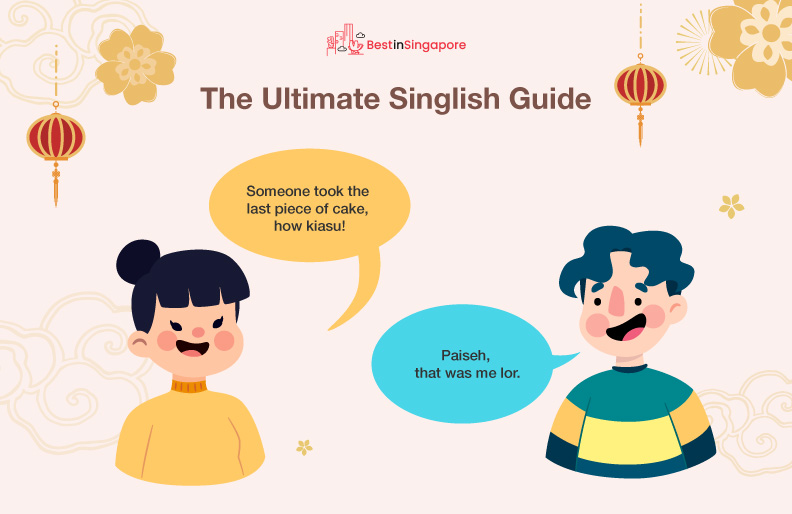
So now that you know a bit more about one of Singapore’s official languages, what next? You learn how to speak the unofficial language, of course!
Singlish is a unique mix of English, Mandarin, Hokkien, Malay, Tamil, and Teochew. If that’s not enough to make you scratch your head, then just you wait until you actually hear the locals speaking it.
Picking up some local phrases can be a fun way to break the ice with Singaporeans. In fact, using it correctly can also make a good impression.
Whether you want to speak like a local or simply want to understand what the locals are saying, we’re here to help you make sense of it all. So, let’s start lah!
21. Lah
No list of essential Singlish phrases is complete without “lah.” Basically, this is a suffix that emphasizes a preceding word or phrase, and can be used in almost any context.
Surprised? Disappointed? Exasperated? Or simply neutral? Just use “lah,” lah.
Example: “It’s too expensive lah!”
22. Can/not
If there’s another Singlish term that you must know, it’s “can,” which simply means “to be able to.” The opposite of that, as you can guess, is “not.”
Example: “Can you take me to the airport?” “Can.”
23. Leh
This is a softer version of “lah” often used to show uncertainty.
Example: “I’m not sure what time she’s arriving leh.”
24. Lor
If that’s not confusing enough, you can also add “lor” to the equation. This is used to convey acceptance or resignation.
Example: “I lost my wallet so I had to walk back home lor.”
25. Eh
This is used to call someone’s attention, which can be likened to “hey!”
Example: “Eh, do you want to get lunch?”
26. Shiok
Use this term to express approval or admiration. Think of “shiok” as a substitute for “cool” or “great!”
Example: “This new mall is so shiok!”
27. Kiasu
Here’s another term that you may have encountered at least once. “Kiasu” is a Hokkien word that literally translates to “fear of losing.”
In Singapore, locals use “kiasu” to criticise someone’s selfish or rude behaviour.
Example: “She took the last piece of cake, how kiasu!”
28. Paiseh
This is another Hokkien term that denotes shame or embarrassment. It’s usually followed by a request or an excuse over something.
Example: “Paiseh, I didn’t have time to clean.”
29. Chope
Now, this would come in handy when you’re in a hawker centre. “Chope” is the practise of placing invaluable objects like tissue papers to informally reserve a table.
Example: “Chope this table before someone takes it.”
30. Siao
A Hokkien term that literally means crazy.
Example: “Why wear a winter coat in this heat? Siao ah!”
31. Tabao
Here’s another example of a term that you can use in hawker centres. Use this if you wish to order food for takeaway.
Example: “Auntie, one chicken rice, tabao.”
32. Bo jio
If you know what FOMO is, then you’ll find that “bo jio” means the same thing. This Hokkien phrase literally means not getting an invitation, often used by the person who wasn’t invited in an event.
Example: “My parents went to Australia and bo jio me!”
33. Alamak
This is a Malay word used to convey shock or surprise, much like “oh my gosh!”
Example: “Alamak! I left my phone at home!”
34. Auntie/uncle
Use auntie or uncle to address elders out of respect. This is often used to address shop owners or hawker vendors.
Example: “Auntie, can I get one laksa?”
35. What
Here’s another versatile word you can use to emphasize your point or to express disagreement. Depending on the context, it can also be used to correct a statement.
Example: “This is a bad deal what, other shops sell it cheaper.”
36. Atas
This Malay word refers to someone or something that’s upscale or high class. Sometimes, it’s also used to describe someone as arrogant or snobbish.
Example: “I don’t have money to dine at this atas restaurant, maybe next time.”
37. Catch no ball
Taken from a Hokkien expression “liak bo kiu,” this phrase is used to indicate that one doesn’t understand what the other is saying.
Example: “Can you repeat what you were saying? I catch no ball.”
38. Aiyoh
This expression appears at the beginning of a sentence, often used to express dismay. Think of it as something like “oh no!”
Example: “Aiyoh, the parking lot is full today!”
39. Die die must try
Ever had something so good that you just had to recommend it to your friends? That’s basically the essence of “die die must try.”
Example: “I’ve never had pizza as good as this one. You die die must try.”
40. Ang moh
Taken from Hokkien, this phrase literally means “red hair” to refer to Caucasians. Depending on the context, using it may or may not be derogatory, so use it with caution.
Example: “I’m having dinner with a handsome ang moh I met at the bar yesterday.”
41. Tompang
This is a Malay word used for hitching a ride or tagging along. Sometimes, it can also be a request to ask someone to buy or get something on your behalf since they’re also doing the same thing.
Example: “Can I tompang your car on the way home?”
42. Sian
This Hokkien expression is used to refer to boredom or something that’s tiring. It’s often a complaint that you’ll hear when someone has to do something they don’t want to do.
Example: “I need to work overtime today. Sian.”
43. Makan
If you wish to invite someone out for lunch or dinner, you simply ask them if they want to “makan” with you.
Example: “I’m hungry lah. Let’s go makan?”
44. Wah lau eh!
This expression is used to exclaim disbelief or surprise often for something that’s not pleasant. In Hokkien, “wah lau” literally means “oh my dad,” with “eh” being added for emphasis.
Example: “Wah lau eh! I thought I already fixed that!”
45. Confirm plus chop
This simply means that you’re completely sure of something.
Example: “I swear I already booked the tickets, confirm plus chop.”
46. Jiak ba bui?
Here’s another food-related phrase that Chinese locals can appreciate. You’re literally asking them if they’ve eaten yet—a polite gesture that’s akin to asking someone how their day is going.
Example: “It’s getting late already. Jiak ba bui?”
47. Talk cock
This slang phrase is used to describe something as nonsensical. Fair warning: make sure to only use this in Singapore.
Example: “Stop talking cock. I know the truth.”
48. Sui/swee
Use this Hokkien term if you think something is beautiful.
Example: “I saw a very swee dress on display today.”
49. Shag
Again, it’s not what you think it is. In Singapore, “shag” is used to describe extreme exhaustion.
Example: “I’m so shag. I stayed up all night finishing this TV series.”
50. Why you so liddat?
Finally, you may have also heard this a lot. “Why you so liddat” is an abbreviated form of “why are you like that,” and is commonly used to express dismay.
Example: “You cut me off again. Why you so liddat?”
Resources for Translation

Still confused after reading all this? Just whip out your smartphone and use a pocket translator instead.
They’re fantastic tools that allow you to converse with locals easily—no need to worry about language barriers!
Even if you know a local phrase or two, it would be helpful to download these apps before your trip, just in case the situation calls for it.
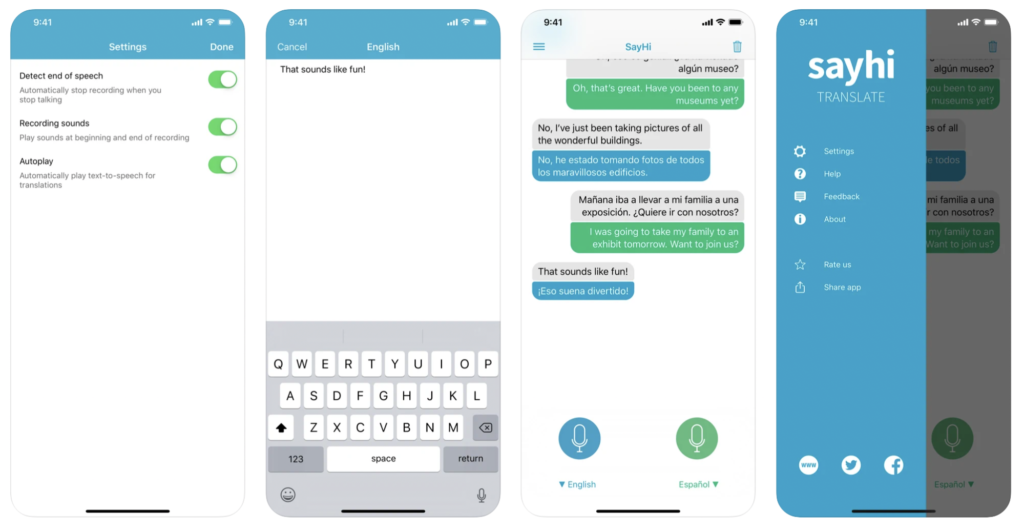
You can have a full conversation (or at least a passable one) with Amazon’s SayHi app. The app supports 101 languages and dialects, which you can check out here.
Simply select the language of your choice, tap the microphone icon, speak, and the app will automatically do all the translating for you. You can also tap and hold the microphone icon to type.
Unlike most translation apps, this one’s completely free from cost and ads—with one caveat, however. You’ll need an internet connection to use the app.
Available on App Store, Google Play, Amazon App Store
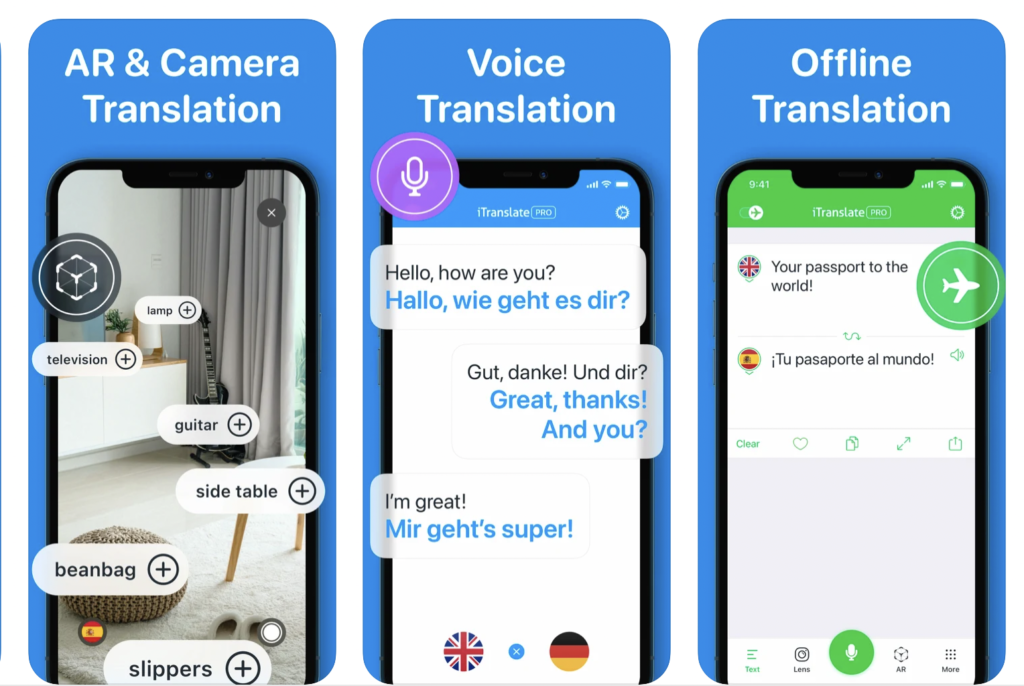
iTranslate is arguably one of the most comprehensive translating apps available right now. It offers text translation, voice translation, and even camera translation to instantly translate menus, cards, and signages.
The app supports over a hundred languages, with select others available in offline versions so you don’t have to worry about data roaming charges.
We love how easy transliteration is with this app. This means that it has the ability to read non-Latin characters, which turns “你好“ into “Nǐ hǎo.”
Unfortunately, the free version is limited to text translation only. You’ll need to subscribe to the paid version to unlock the best features of the app including voice and photo translation.
Available on App Store, Google Play

Launched in iOS 14, Apple’s Translate app makes a great choice if you’re looking for a straightforward and easy to use translation tool. This free app supports several major languages including Mandarin, English, Korean, and more.
While the app’s lineup of languages isn’t as extensive as others, this one earns a point for its ability to translate without WiFi. Just download the language beforehand in order to use it in offline mode.
You can also translate a conversation in offline mode. You only need to tap the microphone icon once and the app automatically detects when you start speaking and when you stop.
Available on iOS only

Microsoft’s Translator app is another life-saving tool that can help you get out of awkward conversations. From voice to text translations, this all-around app allows you to interact with locals with ease.
It also features a camera mode, which has the ability to translate signages and labels. The app supports over a hundred languages too, from Tamil to Greek.
There are no costs involved in this app, except data roaming charges that you’ll need upon using its features. On the bright side, it does support many languages in offline mode, so make sure to download it beforehand.
But perhaps our favourite thing about this app is its phrasebook feature, which gives you quick access to the most common phrases of a particular language—making it the perfect travel companion.
Available on App Store, Google Play, Amazon App Store
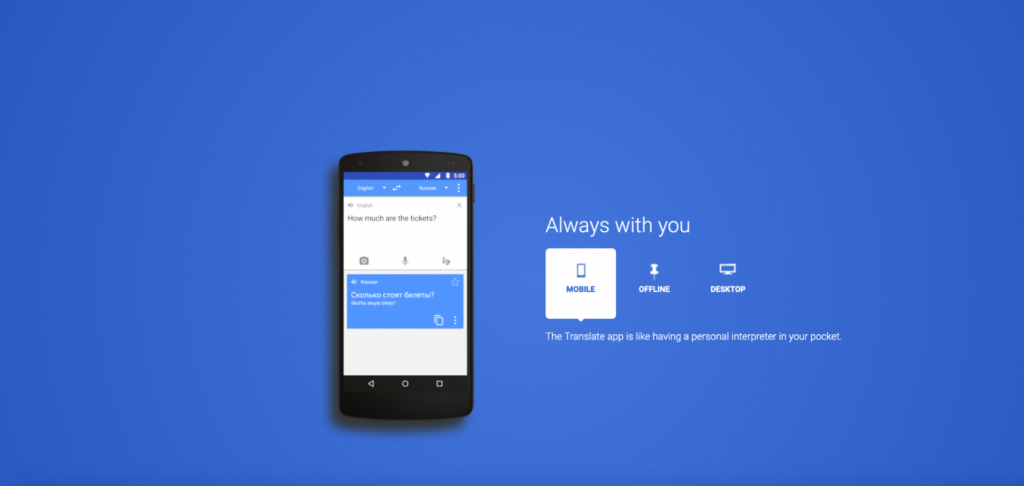
This trusty app is another accessible resource you can turn to. You can speak, type, write special characters, and snap photos for translation.
Supporting over a hundred languages, this app easily offers one of the widest coverage in terms of all features mentioned above. For instance, Google Translate can support offline versions and photo-reading capabilities of many languages compared to its rivals.
That said, Google Translate doesn’t provide the most accurate translation out there though, particularly longer and more complex sentences. But for what it’s worth (which is basically nothing since it’s free), it does provide everything you need translation-wise to get by in Singapore.
Available on App Store, Google Play
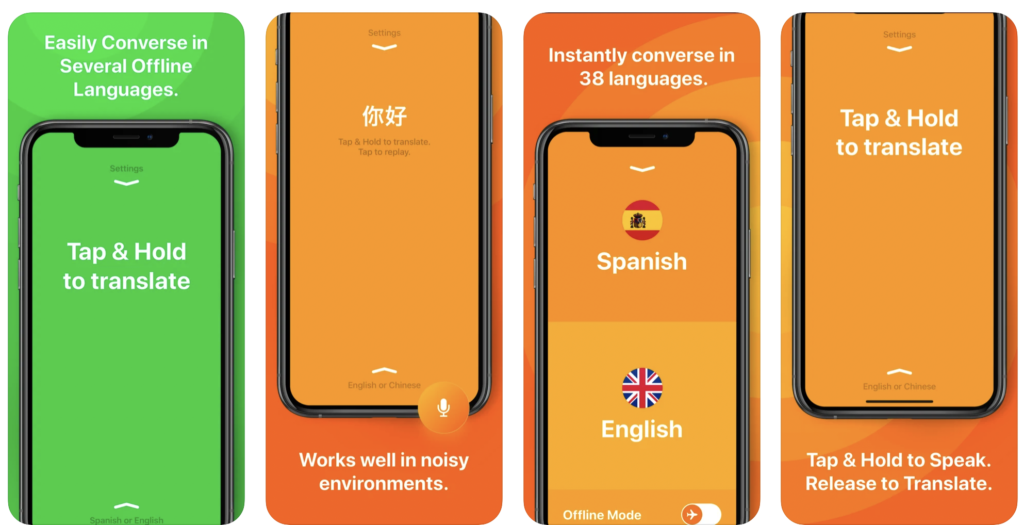
iPhone users, listen up: iTranslate’s younger sibling is a good choice if you’re looking for a two-way translation tool. It does exactly what it’s expected to do—to detect 2 distinct languages in a conversation and translate them.
It supports 38 languages and while it’s not as diverse compared to others, it covers the most essential ones in Singapore including Mandarin, Cantonese, and Bahasa.
Its interface is quite simple: simply set the languages, tap and hold to speak, then release to translate.
We noticed that it has trouble detecting long sentences though, so make sure to divide your sentences into parts if needed. You’ll also need to go online to use this app, unless you’re subscribed to iTranslate PRO, in which you can use its offline mode.
Available on App Store
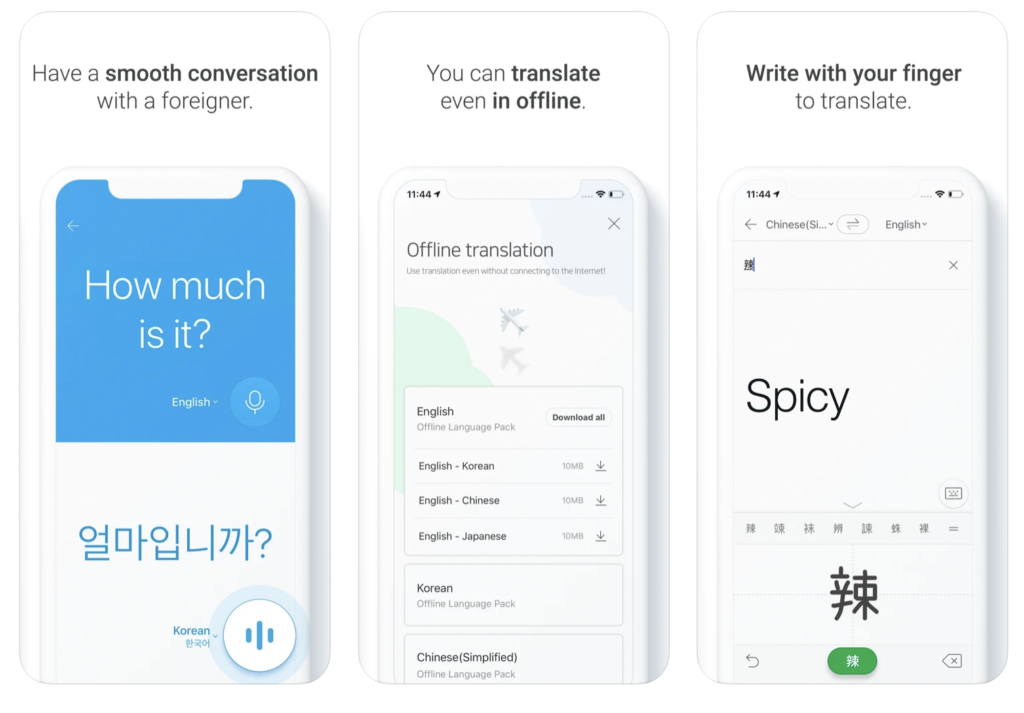
Papago is specifically designed to translate East Asian languages—Korean, Chinese, and Japanese, and they do a pretty good job on it compared to its competitors.
It can do text, voice, and photo translation, with an ability to translate simultaneous conversations.
Unique to Papago is its photo translation feature. The interface allows you to zoom into the picture and highlight specific words or phrases that you’d like to have translated.
To get the most out of this app, you’ll have to go online. Otherwise, it offers offline English to Chinese/Korean/Japanese language packs—which are all free to download, by the way.
Available on App Store, Google Play
- Photo Translator

Travelling around Asia can be tricky when you have non-Latin characters everywhere. Photo Translator can help you translate those words and symbols quickly with a few clicks.
Just take a photo of the text and poof comes a translated version on top of the original picture. It supports over a hundred languages regardless if you’re connected to the internet or not.
Sadly, you’ll need to subscribe to the premium version to enjoy additional features including unlimited photo translation and access to all supported languages.
Available on App Store, Google Play
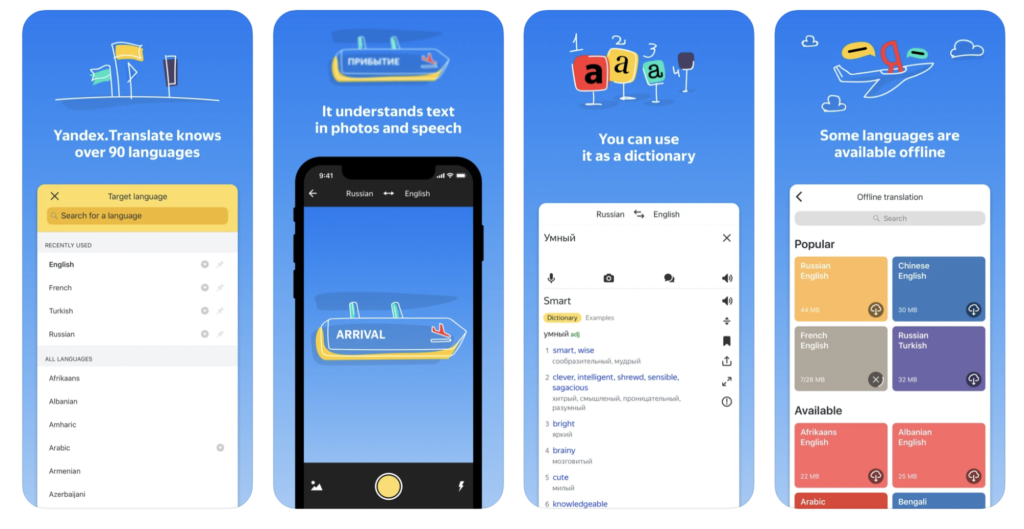
Here’s another free translation app that you can download: Yandex Translate supports over 95 languages when you’re online. You can also snap a photo or upload one from your camera roll to view its translation right over the image.
While most features require you to go online, you can download language packs for free so you can use text and voice translation on the go.
This app features a handy dictionary that’s available for most supported languages. On top of that, the app also allows you to make folders of words or phrases that you’ve learnt.
Available on App Store, Google Play
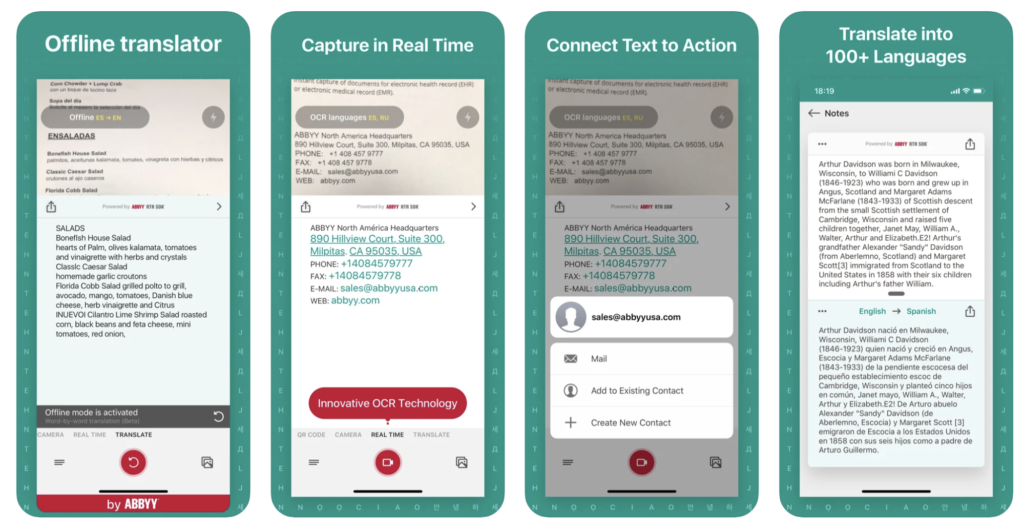
Text Grabber has the ability to digitise printed text and translate it. From what we’ve seen, the app works best for newspapers and any form of legible text on flat surfaces.
With over 100 supported languages, this app can translate text in real time—no need to capture photos.
We’ve noticed that this feature is only ideal for short words and phrases, seeing that it can take some time to process longer and complex sentences. In that case, you can capture your text instead in order to benefit from several features like copy, share, call, and send emails, etc.
Note that this app requires a premium subscription to use.
Available on App Store, Google Play
Translation apps are nifty and all, but for the translation of important documents such as business papers, technical guides, and more, you’re better off hiring a professional translation service. If ever you find yourself in need of one in Singapore, we’ve got you covered with our list of the best translation services in Singapore.
And with that, we end our list of the 50 most essential phrases to know in Singapore. Think there are others that we failed to mention? Drop us a line!
If you’re a tourist discovering this website for the first time, we’ve written about many places and services that you can check out on your trip. For starters, here’s a detailed guide of must-visit museums in Singapore.

